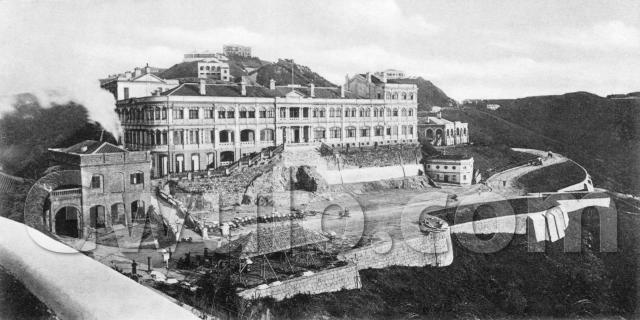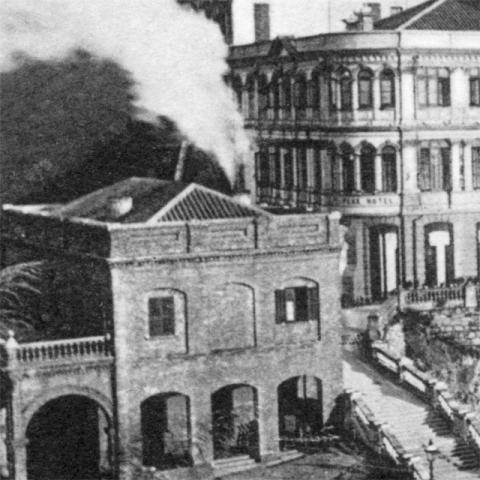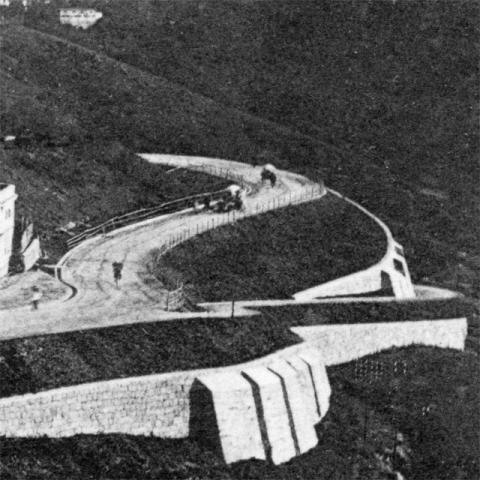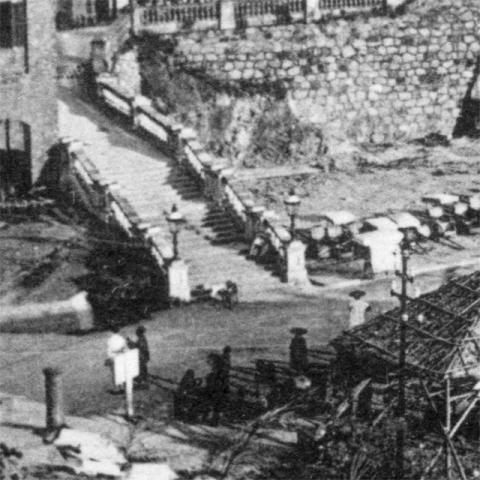Where: We're looking across at the Peak Hotel, where the Peak Galleria stands today. You can just make out its name on the corner of the building:
The building on the left is the upper terminus for the Peak Tram. The clouds of smoke and steam come from the coal-fired steam engine that pulled the trams up the hill.
My first guess for where the photographer stood was up on the slope of Mount Austin Road. But comparing it with other photos of the Peak Hotel, the angle isn't quite right. More likely he was standing outside the #6 Police Station [1], up the slope above Mount Austin Road.
Across to the right of the photo, the road forks:
The upper road is called Peak Road today, but then it was known as Chamberlain Road. The road forking down the slope leads to the Pokfulam Reservoir.
Who: The photo above shows a couple of sedan chairs moving along Peak Road, probably heading to or from the Peak Tram.
Nearer the camera you can see a group of people in the shadows. They are the chair coolies, the men who carried the sedan chairs, waiting for the next tram to arrive and bring them customers.
We can't see any of the hotel's residents in the photo. If we could, we'd find a mix of people - some visiting as tourists, others living there long-term. We can get an idea of the long-term residents at least from the Jurors Lists. In the 1900 list [2] the following men gave the Peak Hotel as their home:
- John du Flon Hutchinson, Merchant
- Alexander Findlay Smith, Merchant, MacEwen Frickel & Co.
- Arthur George Stokes, Broker
- George Harry Dann, Assistant, H. Wicking
- Andrew Forbes, Assistant, Bradley & Co.
- John Ernest Lee, Architect, Leigh & Orange
- Carl Wilhelm Longuet, Merchant, Kruse & Co.
- Charles Eugene Maligny, Assistant, China Traders Insurance Co. Ltd.
- Robert Mitchell, Draughtsman, Hongkong & Whampoa Dock Co. Ltd
- Alexander Moir, Manager, Peak Hotel
- Bertie Walter Morrell, Local Manager, South British Insurance
And "long term" could be very long. We have consecutive years' Jurors Lists from 1894 til 1913. Of those, Arthur George Stokes appears in the lists from 1894 til 1904, again in 1906, and always living at the Peak Hotel!
What: The hotel is the centre of attention, but take a look back to the previous photo for a moment - there's an old pillar-style postbox, down to the left. Now back to the hotel:
It went through many changes over the years. Originally it was the same height all the way across, but here we can see the right end has had an extra storey added. It must have worked out well, as later photos show the extra floor was extended across the full length of the building.
The centre of the building has the main entrance. There used to be three paths to it - one from either side, and one sweeping drive that lead down the hillside in front of the building. Here most of that slope has been dug away to create a flat piece of land in front of the hotel. In later photos, an annexe has been added to the hotel, built on that flat land.
When: The postbox gives us a starting date, as it was erected in 1892. And in early 1901 a stone-built chair-shelter replaced the matshed shelter shown here, so the photo must have been taken before then. (The stone shelter still stands today. In 1947 it was converted to the Peak Cafe, and is now called the Peak Lookout.)
I'll guess 1900 as the date, but if you can narrow it down any more, please leave a comment below.
Regards, David
References:
Reference: EC016





Comments
Chamberlain Road and Chair Shelter
Chamberlain Road, running from the Upper Peak Tram Station in front of Peak Hotel and then uphill, can assist to date this pic as the following observations suggest it was under construction when the photo was taken.
Fortunately, the 1897 (1) and 1898 (2) PWD Reports summarize the progress of construction of Chamberlain Road. It was built in two sections. The section seen in the photo, between the Upper Tram Station and the entrance to Treverbyn, was started in November 1897 and the whole project was completed in December 1898.
Logically, the buttresses and retaining walls would have been built early in the process, whereas top surfacing of the road and a permanent border wall would have been amongst the last tasks completed. Therefore, the photo was probably taken towards the end of the construction project, i.e. in late 1898.
Partial corroboration of this date is found in the same source (1) where it reports on plans to build a Chair Shelter, i.e. the matshed on the stone sided platform at the bottom of the photo. Published in May 1898, the Report uses the present tense and states;
“…a suitable area is being levelled for the accommodation of chairs...”
As the photo shows the levelled site with a matshed built upon it, it must have been taken in or after May 1898.
(1). Para.40 of 1897 Report of Director of PW, found in Government Gazette 241/1898, published 28 May 1898. Para.40.
(2). Para.58 of 1898 Report of Director of PW, found in Government Gazette 323/1899, published in June 1899.
1890s Peak Hotel
For comparison. Early days of the Peak Hotel (2nd generation), without the matshed chair shelter, additional storey of the Peak Hotel on the right etc